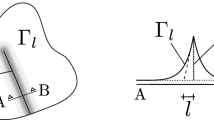Abstract
This work introduces a novel mathematical model of the stresses around the tip of a fatigue crack, which considers the effects of plasticity through an analysis of their shielding effects on the applied elastic field. The ability of the model to characterize plasticity-induced effects of cyclic loading on the elastic stress fields is assessed and demonstrated using full-field photoelasticity. The focus is on determining the form of the shielding stress components (induced by compatibility requirements at the elastic–plastic interface along the crack flank and via the crack tip plastic zone) and how they influence the crack tip elastic stress fields during a load cycle. The model is successfully applied to the analysis of a fatigue crack growing in a polycarbonate CT specimen.
Similar content being viewed by others
References
Ayatollahi MR and Safari H (2003). Evaluation of crack tip constraint using photoelasticity. Int J Press Vess Piping 80: 665–670
Bradley WB and Kobayashi AS (1970). An investigation of propagating cracks by dynamic photoelasticity. Expl Mech 10(3): 106–113
Diaz FA, Patterson EA, Tomlinson RA and Yates JR (2004). Measuring stress intensity factors during fatigue crack growth using thermoelasticity. Fatigue Fract Eng Mater Struct 27(7): 571–584
Elber W (1970). Fatigue crack closure under cyclic tension. Eng Fract Mech 2(1): 37–45
Irwin GR (1958) Discussion of the dynamic stress distribution surrounding a running crack—a photoelasticity analysis. In: Wells A, Post D (eds) Proc. of the society of stress analysis, vol 16, pp 93–96
James MN (1997) Some unresolved issues with fatigue crack closure—measurement, mechanism and interpretation problems. In: Karihaloo BL et al (eds) Proc. of the ninth international conference on fracture, vol 5. Pergamon Press, Sydney, Australia, April 1997, pp 2403–2414
James MN, Pacey MN, Wei LW and Patterson EA (2003). Characterisation of plasticity-induced closure—crack flank contact force versus plastic enclave. Eng Fract Mech 70: 2473–2487
Kfouri AP (1986). Some evaluations of elastic T-term using Eshelby’s method. Int J Fract 30: 301–315
Muskhelishvili NI (1977). Some basic problems of the mathematical theory of elasticity, 4th edn. Noordhoff International, Leyden, The Netherlands
Nurse AD and Patterson EA (1993). Determination of predominantly mode II stress intensity factors from isochromatic data. Fatigue Fract Eng Mater Struct 16(12): 1339–1354
Olsen PC (1994). Determining the stress intensity factors K 1, K II and the T-term via the conservation laws using the boundary element methods. Eng Fract Mech 49(1): 49–60
Pacey MN, James MN and Patterson EA (2005). A new photoelastic model for studying fatigue crack closure. Expl Mech 45(1): 42–52
Sanford RJ (1979). A critical re-examination of the Westergaard method for solving opening-mode crack problems. Mech Res Commun 6(5): 289–294
Sanford RJ and Dally JW (1979). A general method for determining mixed mode stress intensity factors from isochromatic fringe patterns. Eng Fract Mech 11: 621–633
Sham TL (1991). The determination of the elastic T-term using higher order weight functions. Int J Fract 48: 81–102
Sherry AH, France CC and Goldthorpe MR (1995). Compendium of T-stress solutions for two and three dimensional cracked geometries. Fatigue Fract Eng Mater Struct 18(1): 141–155
Shterenlikht A, Díaz Garrido FA, López-Crespo P, Withers PJ and Patterson EA (2004). Mixed mode (KI + KII) stress intensity factor measurement by electronic speckle pattern interferometry and image correlation. Adv Mech Mater 1–2: 107–112
Sih GC (1966). On the Westergaard method of crack analysis. Int J Fract 2(4): 628–631
Taroni M, Patterson EA (2000) Comparative photoelastic analysis of elliptical cracks in a compressor disc.In: Proc. SEM IX int. congr. on exptl mechs, Orlando, FL, pp 100–103
Williams ML (1957). On the stress distribution at the base of a stationary crack. J Appl Mech 24: 109–114
Author information
Authors and Affiliations
Corresponding author
Rights and permissions
About this article
Cite this article
Christopher, C.J., James, M.N., Patterson, E.A. et al. Towards a new model of crack tip stress fields. Int J Fract 148, 361–371 (2007). https://doi.org/10.1007/s10704-008-9209-3
Received:
Accepted:
Published:
Issue Date:
DOI: https://doi.org/10.1007/s10704-008-9209-3




